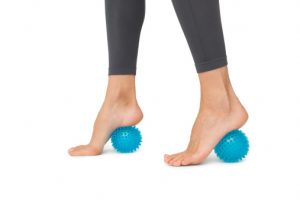 Heel spurs with plantar fasciitis can cause heel pain while standing or walking. A heel spur is a pointed bony outgrowth of the heel bone. If located underneath the sole, it is associated with plantar fasciitis. Heel spurs can occur on their own or be triggered by an alternative cause.
Heel spurs with plantar fasciitis can cause heel pain while standing or walking. A heel spur is a pointed bony outgrowth of the heel bone. If located underneath the sole, it is associated with plantar fasciitis. Heel spurs can occur on their own or be triggered by an alternative cause.
A heel spur can also be located at the back of the heel, under the heel, or beneath the sole of the foot. Heel spurs at the back of the heel are often related to the Achilles tendon and can be most painful when pushing off the ball of the foot.
Painful heel spurs related to plantar fasciitis
Advertisement
As mentioned, if pain is experienced underneath the sole of the foot, most likely the heel spur is related to plantar fasciitis. This type of pain is worsened when stepping down on the heel.
Heel spurs and plantar fasciitis can occur separately or together and can even be the result of other conditions, such as arthritis, ankylosing spondylitis, and diffuse idiopathic hyperostosis. In some cases, heel spurs may be symptomless and a patient can only find out about their heel spur while undergoing an X-ray.
Symptoms, risk factors, and other causes of heel spurs
A heel spur is often caused by calcium deposits, which develop underneath the heel bone over the course of a few months. Heel spurs can cause strains on the foot muscles and ligaments, and over time can lead to tearing of the membrane that covers the heel bone.
Risk factors for heel spurs include walking gait abnormalities (for example, too much stress on the heel), running or jogging, poorly fitted shoes lacking support, and being overweight. Other risk factors include old age, diabetes, standing for long periods of time, frequent short bursts of physical activity, and having either flat feet or high arches.
Heel spurs can be symptomless, but some symptoms experienced include chronic pain that worsens during walking or running and a dull pain that is severe in the morning and dulls down as the day goes on. Over time, as the plantar fasciitis progresses and the heel bone continues to deteriorate, the pain worsens.
Treat heel spur pain with natural home remedies
In order to better treat the pain associated with heel spurs, here are some effective home remedies you can try.
- Soak your foot in apple cider vinegar as it can help relieve inflammation.
- Apply ice packs, especially after active use of your feet.
- Make a baking soda paste and apply it to the affected area.
- Soak the foot in Epsom salt.
- Apply coconut oil to the area.
- Soak a cheesecloth in heated flaxseed oil and wrap it around the area to be absorbed.
- Mix borax with chlorinated water and soak your foot 30 minutes prior to bed.
- Perform calf stretches, foot rotations, cycling, or swimming.
- Wear proper fitting shoes.
- Maintain a healthy body weight.
- Use a heel cushion in your shoes.
- Don’t walk around barefoot, especially on hard surfaces.
- Stretch your feet upon awakening.
- Avoid standing for long hours.
- Take calcium magnesium supplements, but speak to your doctor prior.
- Reduce stress.
- Try yoga or meditation.
- Try acupuncture.
- Use over-the-counter pain relievers.
Exercises for heel spur pain treatment
Advertisement
As mentioned, some exercises can actually benefit heel spur pain. Here are some exercises you can try to improve heel spur pain.
- Place one foot in front of the other with arms stretched forward for balance. Begin to bend your knees until you feel a stretch in your calves. Hold this position, then switch feet.
Lean forward against a wall with one knee straight and your heel on the ground—the other knee should be bent. You should feel a stretch in the calf of the straight knee. Hold for 10 seconds, release, and repeat. - Another move is referred to as the “Towel Pickup,” and involves laying a hand towel flat on the floor then trying to pick it up and move it towards you using your toes
- Table stretches are also useful in treating heel spurs. Brace yourself against a table with your hands and bend one knee forward while stretching the other. Lean forward as if you were going to push the table and stretch the calf muscle for 10–15 seconds, then switch sides.
- You can also relieve heel spur pain with an exercise called shin tracing. Begin be sitting on a chair with your feet flat on the floor in front of you. Lift the foot that is sore and slowly trace it up and down the shin of your other leg in order to help the muscles around the heel spur relax.
- Rolling a small ball with the sole of your foot can act as a sort of massage and relieve muscle tension.
- Fascia stretching may also help alleviate pain associated with heel spurs. To begin, sit on the floor with your legs stretched out in front of you and place a towel around one of your feet. Pull on the towel until it is fully stretched and hold this position for 10 seconds.
It’s important to note that exercise should be gentle and you should not push yourself to the point of further injury. Exercise is a possible cause of heel spurs, so it’s important to be mindful of not overexerting your heel and to switch up your exercises in order to strengthen all parts.
Related: Thumb joint pain: Causes and treatment options
